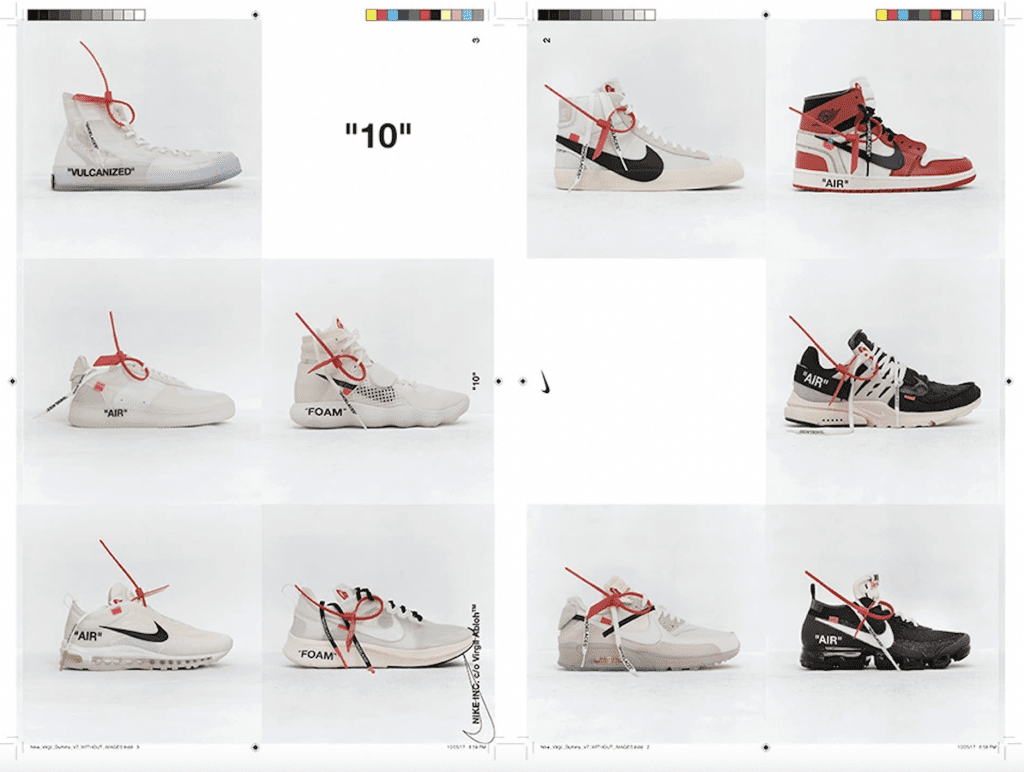Off-White has an interesting new trademark registration in its portfolio of word marks, diagonal stripes, and arrow logos. As indicated by way of a registration dated March 29, the U.S. Patent and Trademark Office (“USPTO”) has agreed to add Off-White’s red zip tie mark for use on footwear to its Principal Register. Specifically, the trademark at the center of the new registration consists of the “three-dimensional configuration of a zip tie with a substantially rectangular end, all in the color red as used on footwear,” and also extends to the specific “position of the mark on the goods.” It is attached to the laces, near where the tongue and upper eyestay meet.
The registration follows from a nearly four-year-long back-and-forth between Off-White and examining attorneys for the USPTO after counsel for the brand – which was founded by the late Virgil Abloh – first filed an application for registration for the zip tie-centric mark back in July 2018. The application was met with notable pushback from the USPTO almost from the outset, with an examining attorney for the trademark office first asserting back in December 2018 that the red zip tie could not be registered for a number of reasons, including a likelihood of confusion with already-registered marks and given that the “configuration of the zip tie,” itself, is functional. In terms of the latter refusal, the USPTO’s examining attorney suggested that Off-White amend its application to only claim rights in “the position or placement of” the zip tie in connection “with the identified goods” – and not in the design of the zip tie, itself.
Counsel for Off-White did eventually amend its description of the mark, which originally – and very broadly – described the mark as (and thus, claimed rights in) “a red zip tie” for use on “Tops; bottoms; headwear; footwear” in Class 25, and “Handbags; wallets; backpacks” in Class 18. The description of the mark was subsequently narrowed quite a bit to reflect a more limited mark that consists of the specifically positioned “3D configuration of a zip tie with a substantially rectangular end, all in the color red as used on footwear.” (Tops, bottoms, and headwear were dropped from Class 25, and Class 18 was dropped from the application in its entirety.)
In additional Office Actions, the USPTO posed more pushback, preliminarily refusing to register the zip tie mark on the basis that it “appears to be a functional design,” and pointing to examples of red zip ties available for sale on sites, such as Amazon, as evidence of the fact that “neither the design nor the color of [Off-White’s] zip ties is distinctive … [or] used for [source] identification purposes.” (Off-White responded to this, arguing that it is unaware of any other third party offering the same goods that utilizes a red zip tie.)
Beyond that, the USPTO characterized the mark as “a nondistinctive product design or nondistinctive features of a product design” that is not registerable without “sufficient proof of acquired distinctiveness.”

Among other things, counsel for Off-White argued along the way that the zip tie design is not merely a functional element, but instead, “an ‘arbitrary flourish’” that does, in fact, serve the purpose of identifying the source of [its] goods.” Off-White alleged at one point that the red zip tie is such a significant indicator of source in the minds of consumers that “when consumers see [it] affixed to [Off-White’s] goods,” including on garments/accessories worn by a long list of mega-stars, “they immediately understand the product to have originated with [Off-White].”
The brand also asserted that the appeal of the zip tie for consumers and celebrity fans of the brand, alike, has little – if anything – to do with “how [the red zip tie] looks” and is derived more from “the message it conveys to others,” namely, that “this is a product produced by [Off-White].” In this same vein, Off-White told the USPTO in one of its responses that many consumers who purchase Off-White products bearing the red zip tie actually “choose to leave [the zip tie] affixed to the outside of the product, even though it could be easily removed.” The reason for doing so, per Off-White? So that they can “communicate to other consumers that the shoe is a product of [Off-White],” one of the most popular brands in the fashion/streetwear market.
(It is worth noting that in response to an ornamentality refusal from the USPTO, Off-White argued that “the mere fact that a trademark can be seen on the product cannot automatically mean that it is a decorative or ornamental feature of the goods.” Indeed, the USPTO has “long held that matter that is primarily perceived as an indicator of source and that is only incidentally ornamental or decorative, can be registered as a trademark,” according to Off-White.)
The desire of consumers to keep the zip tie intact on their footwear due to the information it sends to others is a critical point, per Off-White, and a function that “is no different than any other trademark that appears affixed to fashion products.” In fact, the draw – and the significance – of branding is especially significant when it comes to high-fashion products, Off-White contends, “for which the communication to others that the product is produced by a certain source is much of the attraction of purchasing, owning, and wearing the product in the first place.” Off-White’s use of the zip tie is essentially no different than any other use of a high-fashion trademark, and thus, may not actually be as “unconventional” a trademark as initially meets the eye in light of its overarching ability to indicate source of the product to which it is affixed – no matter the medium.
The wildly valuable marks that traditionally adorn luxury goods (and that convey marketing-built messaging to consumers and that command pricing power) usually come in the form of word marks, logos, and/or monograms. The fact that branding for Off-White comes in the form of red zip ties and quotation marks (two of Off-White’s quotation mark-centric applications for registration are still pending before the USPTO) but nonetheless, serves the same purpose as stalwart luxury brand’s marks is, of course, a particularly interesting and compelling argument given that Abloh, who died in November from a rare form of cancer, was particularly skilled at putting a modern interpretation on what luxury could/should look like – from the garments, themselves, right down to their branding.
Ultimately, instead of relying exclusively on word marks and logos (Off-White does use and have registrations for those), Abloh took the notion of what has traditionally acted as a source-indicator and flipped it on its head in order to successfully cater to a new generation of luxury consumers.











